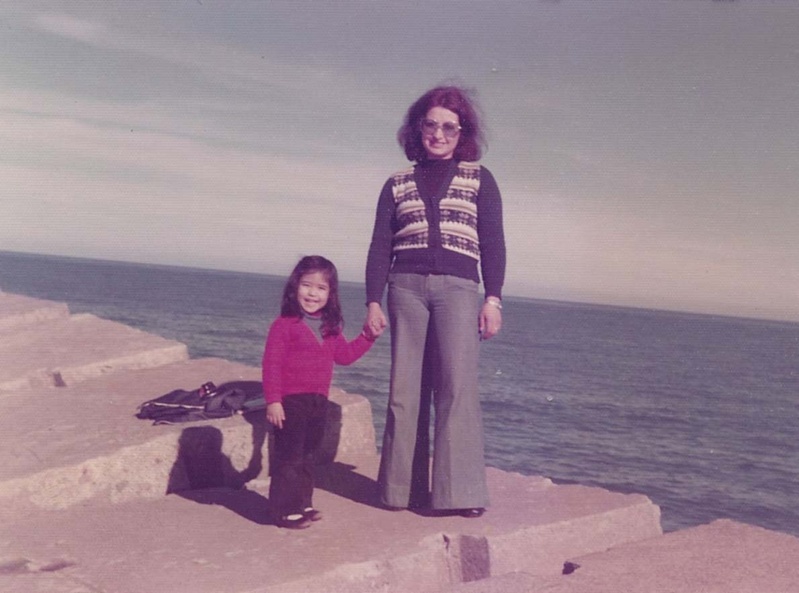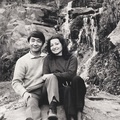Read part 2 >>
Drink Bresolin
My family went through a very difficult time when my dad was taken away. My mother never felt defeated, every day was another day, another opportunity to find her husband. He would leave early and return late, while I stayed with my grandmother Teresa, waiting for his return. My grandmother would enter my room and we would leave it dark: we would look impatiently through the blinds, with the street light filtering in and drawing lines on the wall. As soon as we heard the noise of the car engine, we ran to the garage to open the heavy door. Those days were endless because I lived in terror that my mother was going to be the next to disappear. She would not be the first nor the last girl who was missing both parents. My mother was not afraid of anyone, she spoke openly as if in Argentina there was democracy and the rule of law.
In misfortune he was lucky enough to meet the sister of another missing Nikkei, Juan Carlos Higa. Higa was a journalist who worked for the newspapers Akoku Nippo and La Plata Hochi , both publications of the Japanese community in Argentina. He was also a literature student and poet. Many of his poems are currently available online. His sister Mary Higa was a catechist and lived in Pompeya, the same neighborhood where my mother had the toy-bookstore and where my paternal grandparents lived. Almost every day before going to open the business, we stopped by Mary and her sister Carmen's dry cleaning shop. It was customary for Beba to talk to Mary while my brother Leo and I played with the dachshund “Blackie” or in the yard of the house.
Mary Higa became a part of our lives. That presence left me calmer. My mother was no longer alone in her search. My mother Beba and Mary Higa decided to join forces to search for other missing Nikkei. Together they founded what is today the Group of Relatives of Detained and Disappeared Persons of the Japanese Community in Argentina. This is a group that after forty years is still searching for Truth, Memory and Justice. The families of the victims want to know the whereabouts of our loved ones. Elsa Oshiro, sister of Jorge Oshiro, who disappeared on November 10, 1976 at the age of 18, is the one who took the place of Mary Higa and Beba. Mary Higa also passed away a few years after Beba. I didn't see Elsa as often as I saw Mary Higa, but she was present in our lives. Currently my contact with Elsa gives me enormous peace of mind. With it I can ask and share things from the past when my memories become blurred.
When my father was kidnapped, Beba decided to send me to the same school that Takashi attended, I suppose so that I would have contact with people from the community who might have known him and have some kind of connection to where he had been.
Every Saturday he got up early and left me at the door of Nichia Gakuin to learn Japanese. I was reluctant until by chance I met Marisa Uehara, her mother Delia, her aunt Beatriz, they were colleagues of my father and my aunt. Yoko. Since they lived in Pompeii they took the tram all together in the fifties, and Delia said that at that time Takashi would run after the tram and hang through the back door to sneak in. It's funny to me to know that my father used to get into mischief as a child like any other kid.
After thirty years, by chance Marisa and I were also classmates, we lived a few blocks away, this time in Boedo. We didn't take the tram but we did take the bus together. We later discovered that our grandparents had traveled on the same ship called the Rio de Janeiro Maru from Japan.
My mother helping when there was a school event at the Japanese school, she became friends with Delia, her husband Julio Uehara and Sumiko Matayoshi, whose daughter Gabriela Matayoshi was always very close. Since they knew our family history, I always had someone to talk to, with whom there was no need to hide the fact that my old man was missing, I didn't need to worry about what to say or not say. Delia and Julio challenged me as if I were another daughter, with them I was able to understand that part of being united, of being connected by the same Okinawan roots and being able to call people who do not share the same DNA family.
Kintsugi , Art Installation
When I wrote my first article about my father (in English only) for the Discover Nikkei publication I had in mind painting portraits of the missing 17 Nikkei. I wanted to look my father in the eyes at least on a canvas and hoped to share the experience with other relatives of the disappeared. While painting the portraits I needed to design a three-dimensional work to hold the paintings. I asked Germano Dalla Pola for help, one of my friends from the artistic high school in Italy who was working in an architecture studio in the city of Denver, which gave us the opportunity to think about the installation. We were able to exhibit the work in the Cultural Space of the National Library of Buenos Aires, in September-October 2016.
I called the exhibition Kintsugi , which is the art of recognizing beauty in imperfection, joining the broken pieces with gold, what is created is a new object that is much more beautiful because it was broken. It seemed appropriate to use the word Kintsugi to recognize the courage of the relatives of the missing to face the pain, to remember those who have lost their loved ones and to try to heal the wounds with gold-art Kintsugi , walking in the present demonstrating resilience and carrying forward the will of those who are no longer with us physically.
It was an unforgettable experience for me to meet other relatives of many of the missing people that I painted for a year. It was intense and difficult work that paid off. I managed to learn and recognize that behind every missing person there is a family, children, partners, parents who suffered at the time of the disappearance and who currently suffer from not knowing what happened and where their remains are. It is a wound that will always remain open because there is no possible closure. Ignoring the issue, trying to forget or deny the facts is absolutely useless: I know this from my own experience.
40 years passed and it was only in the last two years of my life that I was able to begin to process what happened to me and my family. Painting, writing, talking with my family and other relatives of the missing is what helps me look to the future and little by little be able to close the wound that damaged several generations. I think I will be able to breathe freely when one day I find my father's remains. In the meantime, I will continue in any way I can, through paintings or words, remembering the missing Nikkei to confirm that there is still a cause to fight for.
Japan
The Japanese government of Masayoshi Ohira (December 1978 - June 1980) as well as his successors Masayoshi Ito (who governed for only one month), Zenkō Suzuki (July 1980 - November 1982) wanted to strengthen ties with Argentina, probably due to economic interests. that both countries had in common.
One spring morning in 1980 I missed school. It was one of those events that I remember clearly, it was something that never happened because every year ended with perfect attendance. I dressed in my best dress, while listening to Mary and Beba talk about the meeting with the Japanese Consul. They had waited many years for that interview and they were finally going to receive us. We were very hopeful that something was going to change; If Mary's words did not have the desired effect, my task was to remind the Consul that our missing relatives had daughters like me, loved ones who needed to find them and that, with the position they held, they had the possibility of helping us if they had the opportunity. the will and desire to make some gesture.
When that day came, my mother had to work and sent me in her place along with my grandmother Ikuko and Mary Higa to the meeting. We arrived and sat in some leather chairs around the Japanese consul, who couldn't stop smiling and nervously holding his hands. Mary Higa spoke up, but we were unable to convince the consul to intercede for our missing relatives. Before arriving at the interview I felt like the secret weapon of our impossible mission to somehow touch his humanity, but our attempt irremediably failed. With each disappointment, I felt that my father was moving further and further away from our lives. The everyday life to which we were trying to return was no longer going to be possible.
The Italian consul Enrico Calamai
My mother had Italian citizenship and had lived for several years in the province of Vicenza between 1960 and 1964. According to Italian law, my father had acquired Italian citizenship through his marriage. He had his own file at the Consulate like any Italian citizen.
The Italian consul in Buenos Aires was Enrico Calamai. The official processed my mother's Italian passport, so she could leave the country if my father showed up. Calamai touched many lives, he saved many who were persecuted in Argentina. I feel that it also changed the lives of my mother, my brother and I, who were able to see another world and have the experience of living in Italy.
For many years I thought the Italian government deserved the credit for the incredible work of Enrico Calamai in saving so many. However, the reality was different: said government did not want to grant political asylum because they had already had a previous experience with the coup d'état in Chile, in September 1973, where 412 people requested political asylum at the Italian Embassy. The credit belonged to Calamai and not to the government he represented.
© 2017 Gaby Oshiro







